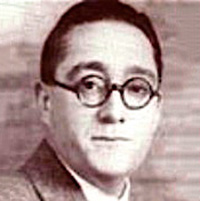Iribe Paul

Iribe, Paul (1883 – 1935)
Among the mavericks of Art Déco is the graphic artist, costume designer, and jewellery designer Paul Iribe. His works – whether designs for furniture, fabric, jewellery, theatrical costumes or stage decorations – exhibit a sense of a whole new style, which departs from Art Nouveau beginning in 1910 to establish a new repertoire of forms.
Born in Angouléme, France, in 1883, Paul Iribe is an artist, journalist, fashion illustrator and designer, and a pioneer of the Art Deco style, which rises to prominence in the 1920s. He studies at the École des Beaux-Arts and the College Rollin in Paris before undertaking an apprenticeship as a printer at Le Temps newspaper.
In 1906 Iribe starts his own periodical, Le Témoin, which drips with social and political criticism. It is this publication and its sketches that bring Iribe to the attention of the fashion designer Paul Poiret. In 1908 Iribe produces a promotional brochure for Poiret, which leads to further requests from other designers, and probably to his first meeting with Coco Chanel.
It is in 1910 that Iribe first branched out to jewellery design, when he illustrates some designs for the goldsmith Robert Linzeler. In an interview with Vogue fourteen years later, Linzeler notes Iribe’s penchant for large stones and a highly decorative approach with unrestrained splendour.
From 1910 the ballet production of Scheherazade by Diaghilev heavily influences the design aesthetics of numerous designers, due to the exotic costumes by Leon Bakst. Turbans and semi-transparent harem trousers are suddenly in vogue, and it is probably due to this influence that Iribe designs the emerald and pearl aigrette (turban brooch). This brooch is made for Iribe’s wife Jeanne Dirys, who wears the piece while acting in the play Le Cadet des Coutras in 1911. It is later acquired by Cartier and is still in the vaults of the London branch in 1931.
From November 1st to 15th 1932, Coco Chanel opens the doors of her own apartment for her diamond jewellery exhibition. The diamond starburst brooch is designed by Paul Iribe and is similar to the style of brooches featured in the exhibition.
Chanel is the original champion of costume jewellery, but under Iribe’s design influence she justifies this display of diamond jewellery against the depressed economic background. Stating that diamonds “represent the greatest wealth in the smallest volume”, she champions a need for authenticity and wants the diamonds presented in their purest form. To this end, hardly any of the settings or clasps are visible, so the stones seem to stand alone.
Iribe marries twice, and it is after his separation from his second wife Maybelle Hogan that his romantic liaison with Coco Chanel begins. They become engaged in November 1933, but never marry due to Iribe’s untimely death at the age of 52 from a heart attack on Chanel’s tennis court in La Pausa in 1935.
Iribe, Paul 1883 – 1935
Zu den Wegbegleitern des Art Déco zählt der Grafiker, Kostumbildner und Schmuckdesigner Paul Iribe. Seine Arbeiten, egal ob Entwürfe für Möbel, Stoff, Schmuck, Theaterkostüme oder Bühnendekorationen, zeigen jenes neue Stilempfinden, das ab 1910 den Art Nouveau ablöst und ein neues Formenrepertoire herausbildet.
Begonnen hat Iribe als Grafiker, dessen Zeichnungen in namhaften Pariser Zeitschriften erscheinen.
1906 gründet er die Zeitschrift „Le Temoin“ und betätigt sich als politischer Satiriker und Gelegenheitsjournalist.
1908 veröffentlicht er das Modealbum „Les Robes de Paul Poiret“, was zu weiteren Anfragen von Modedesigners führt.
Er wendet sich ab 1910 verstärkt dem Kunstgewerbe zu, entwirft Schmuck, Metallarbeiten und Möbel.
Die ersten Versuche im Schmuckdesign macht er für den Goldschmied Robert Linzeler, der noch Jahre später von Iribes Vorliebe für große Steine und seinen ausgeprägten Hang zu ungebändigter Pracht schwärmt. Inspiriert von orientalisch anmutenden Kostümen der Balletts Russes – zu Iribes weitläufigem Freundeskreis zählen Igor Strawinsky, Sergej Djagilev und viele Exilrussen, die seit den 1910er Jahren in Paris leben – entwirft er eine Smaragd-Perlen-Aigrette für seine Frau Jeanne Dirys.
Die bekannte Varietédarstellerin, eine Freundin des ehemaligen Revuegirls Coco Chanel, trägt diesen Turbanschmuck 1911 auf der Bühne.
Später erwirbt sie Cartier, in dessen Londoner Niederlassung das Schmuckstück bis 1931 nachweisbar ist.
Für einige Jahre geht Iribe 1919 für Paramount Pictures nach Hollywood und versucht sich als Kulissenbildner im Filmgeschäft.
1928 trennt er sich von seiner zweiten Frau und beginnt eine Beziehung mit Coco Chanel.
Obwohl sie und Iribe radikal unterschiedliche Ansichten in Modefragen vertreten, arbeiten sie in den 20er Jahren für eine Schmuckkollektion aus Platin und Diamanten zusammen.
1933 verloben sie sich.
Der 52-Jährige stirbt 1935 beim Tennisspiel auf Cocos Feriendomizil in Südfrankreich.